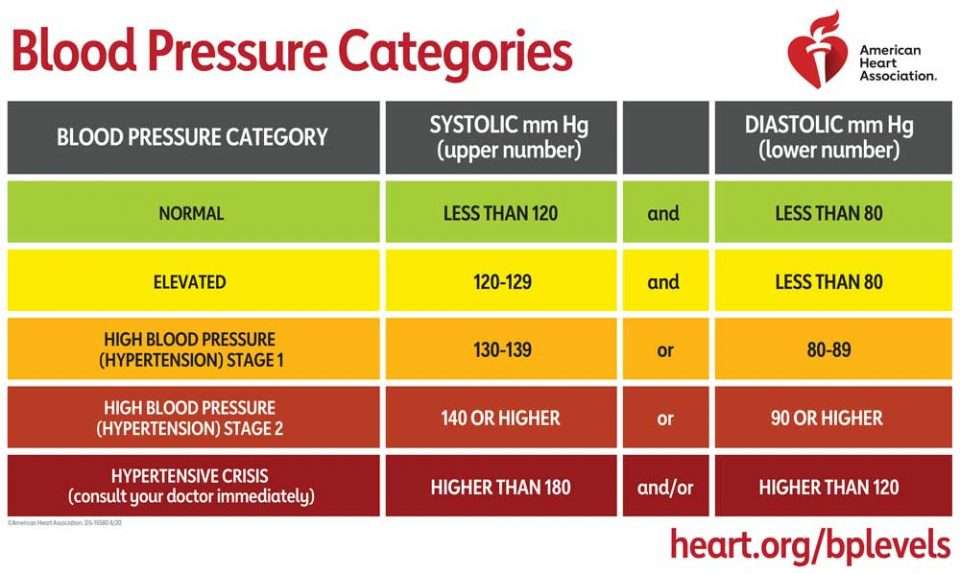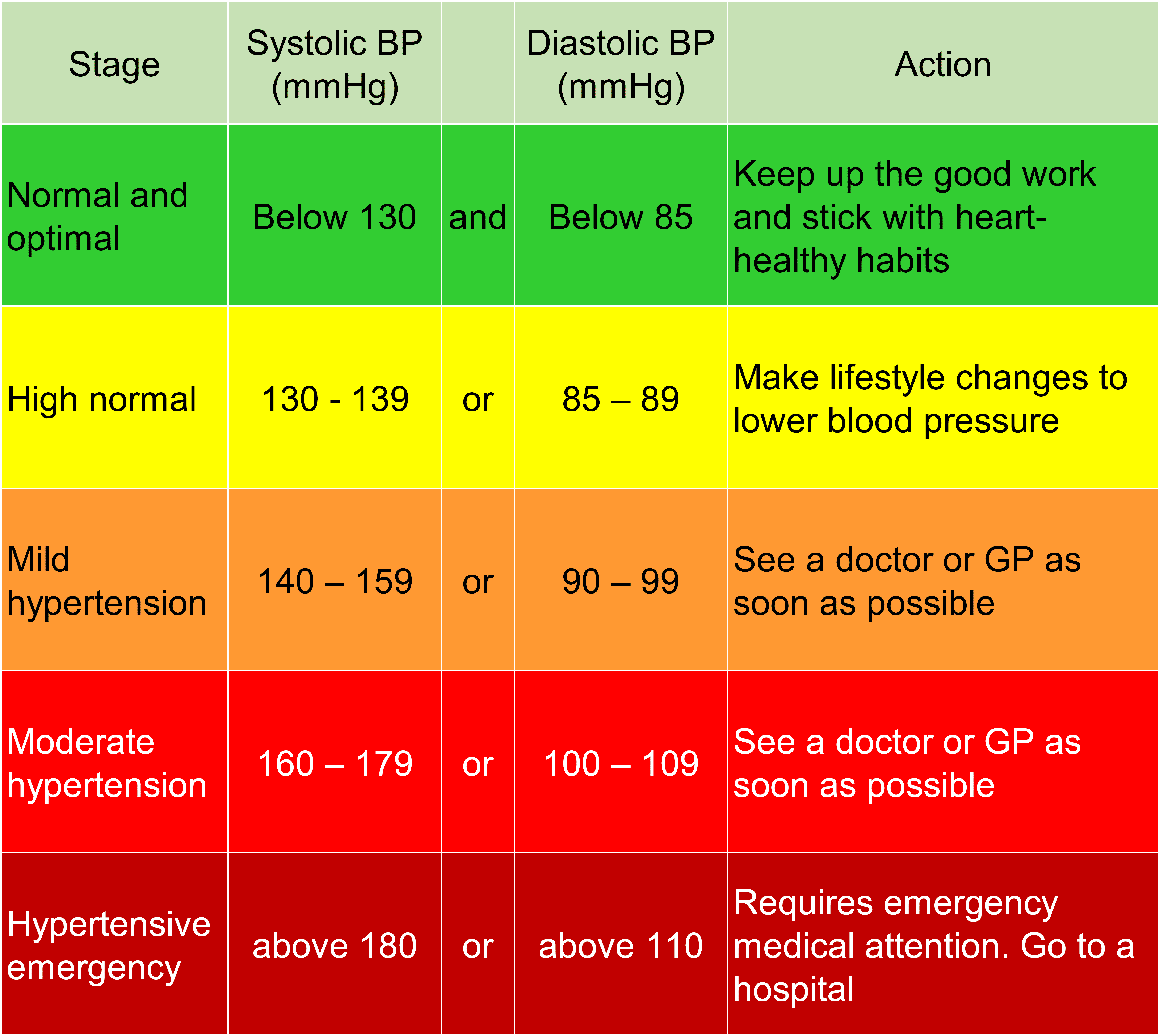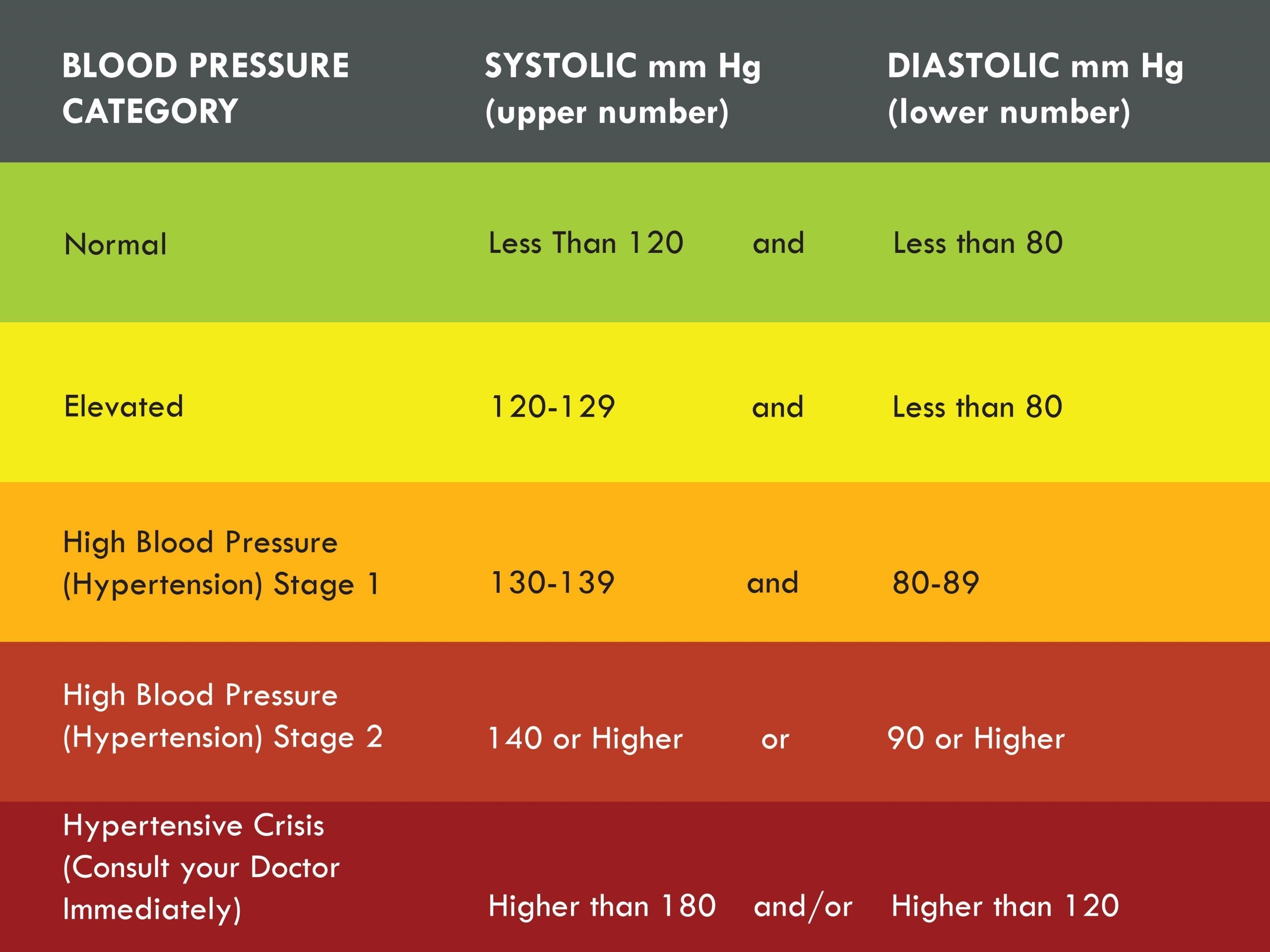From Systolic To Diastolic: We Break Down The Numbers
Understanding your blood pressure is important for keeping yourself healthy. Blood pressure is the pressure of the blood pumping through your blood vessels. The numbers of a blood pressure reading tell a doctor about the force and rate of your heartbeat. It also helps a doctor understand how round and flexible your artery walls are. Blood pressure is taken during different phases of your hearts contractions and expansions.
Average Blood Pressure By Age
As you get older, your blood vessels tend to become stiffer and plaque can build up in them, which can raise your blood pressure. If your blood pressure becomes too high, you’re at a greater risk for heart disease, strokes, and more.
In 2015, the average blood pressure worldwide was 127/79 mm Hg in men, and 122/77 mm Hg in women, according to a study analysis published in Lancet.
When researchers for the National Center for Health Statistics looked at average blood pressure in U.S. adults between 2001 and 2008, the average reading was 122/71 mm Hg. The breakout was 124/72 mm Hg for men, and 121/70 mm Hg in women. It rose by age and was significantly higher in Black people.
The researchers found the following breakdown by age, sex, and race or ethnicity:
| Blood Pressure by Age |
|---|
As the population ages and life expectancy increases, high blood pressure is becoming more common.
How Is Blood Pressure Be Measured
- Sphygmomanometer: A Sphygmomanometer is the traditional rubber cuff found in most doctors offices. This cuff is placed on your upper arm and secured in place. A hand inflation bulb is used to inflate to cuff, causing the circulation in your arm to be blocked. A stethoscope is used to hear the arterial blood flow as the cuff is slowly deflated.
- Electronic Digital Arm Cuff: The electronic digital arm cuff works in the same way as the traditional sphygmomanometer but uses an electronic monitor to capture the arterial pressure changes translating them into the systolic and diastolic readings.
- Electronic Wrist Cuff: The electronic wrist cuff works the same way as the electronic digital arm cuff except is wrapped around the wrist. This device is the easiest to use but also requires following the wrist positioning guidelines from the manufacturer or it will give a false reading.
- That initial pressure measurement on the sphygmomanometer, expressed as millimeters of mercury , is your systolic pressure reading.
- Once the sound of your release blood pressure fades, your caregiver or blood pressure device then uses the second sphygmomanometer reading as your diastolic pressure reading.
Don’t Miss: When Should You Take Blood Pressure
Heart Attack And Heart Disease
High blood pressure can damage your arteries by making them less elastic, which decreases the flow of blood and oxygen to your heart and leads to heart disease. In addition, decreased blood flow to the heart can cause:
- Chest pain, also called angina.
- Heart attack, which happens when the blood supply to your heart is blocked and heart muscle begins to die without enough oxygen. The longer the blood flow is blocked, the greater the damage to the heart.
- Heart failure, a condition that means your heart cant pump enough blood and oxygen to your other organs.
What Causes High Blood Pressure

High blood pressure usually develops over time. It can happen because of unhealthy lifestyle choices, such as not getting enough regular physical activity. Certain health conditions, such as diabetes and having obesity, can also increase the risk for developing high blood pressure. High blood pressure can also happen during pregnancy.
You can manage your blood pressure to lower your risk for serious health problems that may affect your heart, brain, kidneys, and eyes.
Don’t Miss: What To Do To Bring Blood Pressure Down
How Do I Know If I Have High Blood Pressure
Theres only one way to know if you have high blood pressure: Have a doctor or other health professional measure it. Measuring your blood pressure is quick and painless.
Talk with your health care team about regularly measuring your blood pressure at home, also called self-measured blood pressure monitoring.
High blood pressure is called the silent killer because it usually has no warning signs or symptoms, and many people do not know they have it.
When To Call Your Doctor
The risks of both high and low blood pressure make monitoring your blood pressure at home essential to your overall health and well-being. Both Dr. Wong and Dr. Desai recommend calling your healthcare provider if your self-monitored blood pressure readings are greater than 180/120 mmHgeven if you have no other symptoms.
You should call 911 if these blood pressure readings are associated with symptoms of organ damage, such as headache, vision changes, weakness, numbness, chest pain or shortness of breath, says Dr. Wong.
You May Also Be Interested In Blood Pressure Monitor From Our Featured Partner
iHealth Track Blood Pressure Monitor
Recommended Reading: Does Smoking Weed Cause High Blood Pressure
What Is Low Blood Pressure
Low blood pressure may sounds scary but is not always a cause for concern. If youre suffering from low blood pressure you may experience a few mildly unpleasant symptoms, including dizziness, light-headedness and nausea. However, you can help these pass by doing things like standing up slowly, factoring more salt into your diet and staying hydrated.
When To Call Your Healthcare Provider
A hypertensive crisisdefined as blood pressure above 180/120 mm Hgrequires immediate medical attention. Call 911 if you are also experiencing symptoms such as chest pain, back pain, shortness of breath, difficulty speaking, a change in vision, weakness, or numbness.
Don’t Miss: Does Vyvanse Raise Blood Pressure
The Difference Between Blood Pressure And Pulse
Blood pressure refers to the force of blood against the artery walls, whereas a persons pulse indicates the number of times the heart beats per minute.
A resting heart rate is when a person is sitting, lying down, or not engaged in an activity.
An active heart rate is when a person is exercising or engaged in physical activity.
Everyone has a slightly different resting heart rate, but the is between 60 and 100 beats per minute. A physically active person may have a heart rate as low as 40 beats per minute.
Similarly to blood pressure, a persons heart rate or pulse indicates how healthy the heart is.
of blood pressure:
High Blood Pressure And Daily Activity
Check with your doctor before starting a new activity or increasing your level or intensity. Be active safely. Build up your levels of activity gradually.
Try to do at least 30 to 45 minutes of moderate-intensity physical activity on most, if not all, days of the week. This can be done in bouts of 10 minutes or longer, if that is more convenient.
Physical activity is any form of bodily movement performed by our large muscle groups. Moderate-intensity physical activity , such as brisk walking or cycling, is enough to provide health benefits.
Walking is a great activity for all ages. You may like to join one of the Heart Foundations community walking groups.
Some types of exercises, such as body presses and lifting heavy weights, can raise your blood pressure. Avoid these if you have high blood pressure.
Also Check: Does Olive Leaf Extract Lower Blood Pressure
What Are The Stages Of Hypertension
There are various degrees of high blood pressure. Know the difference between the stages to understand the reading.
- Elevated blood pressure means your systolic is 120 to 129 and your diastolic is less than 80.
- High blood pressure/hypertension stage 1 means your systolic is 130 to 139 or your diastolic is between 80 to 89.
- High blood pressure/hypertension stage 2 means your systolic is 140 or higher or your diastolic is 90 or higher.
- Hypertension crisis means you need to seek emergency medical attention because your systolic is higher than 180 and/or your diastolic is higher than 120.
It may take more than reading to confirm a hypertension diagnosis. There are times your blood pressure reading may be elevated because youre nervous about the test. Or theres stress in your life.
Diastolic Blood Pressure In The 50s

Is 50 a normal diastolic number? A diastolic number of 50 is not normal diastolic blood pressure. It is considered low blood pressure. Any diastolic blood pressure number under 60 mmHg is considered low blood pressure.
Low diastolic blood pressure can occur with a low systolic or with a normal systolic pressure. When diastolic is low but systolic isnt, its called isolated diastolic blood pressure. This can be dangerous for your heart 7.
Unlike the rest of the body, your heart receives blood during diastolic, when its not beating. This can lead to symptoms of a weakening heart.
The American Heart Association or the American College of Cardiology hasnt determined a set number range for low blood pressure. Most experts consider low diastolic pressure under 60 mmHg 8.
You May Like: When Is High Blood Pressure An Emergency
What Does My Blood Pressure Reading Mean
The information below and in the related links is designed to help you understand what your latest blood pressure readings may mean for your health. However, this isnt a substitute for medical advice, particularly since a number of personal factors may influence your blood pressure. Please discuss your blood pressure concerns with your doctor or medical practitioner.
How Can Age Affect Blood Pressure
As we get older, and depending on your lifestyle and diet, our arteries change shape and may become stiffer, leading to a greater risk of hypertension. An elevation in systolic blood pressure is the most common form of hypertension in people aged 50 or over . This artery stiffness can also lead to other cardiovascular events, including strokes.
Johns Hopkins has also conducted further research into the link between blood pressure, health, and other age-related conditions: In a 2013 study of 3,000 older individuals, researchers found that participants taking blood pressure medication, such as diuretics and ACE inhibitors, had a 50% lower risk for Alzheimers disease. In another study of African-American men, aged between 2154, Johns Hopkins found that a blend of home visits, medication, and regular medical appointments lowered their blood pressure significantly.
Because of this, its important to maintain a healthy lifestyle throughout your life. Want to find out how to do just that? Check out the following links:
Don’t Miss: What Vitamins Lower Blood Pressure
Why Is Knowing Your Blood Pressure Important
Knowing what your blood pressure is can be incredibly important as it can provide insight into your general health. Keeping track of blood pressure also allows you to recognise when your blood pressure may be rising, or falling. Below is a video explaining why it is important to know your blood pressure.
What Does The Diastolic Blood Pressure Number Mean
The diastolic reading, or the bottom number, is the pressure in the arteries when the heart rests between beats. This is the time when the heart fills with blood and gets oxygen.
This is what your diastolic blood pressure number means:
- Normal: Lower than 80
- Stage 2 hypertension: 90 or more
- Hypertensive crisis: 120 or more. Call 911.
Our chart below has more details.
Even if your diastolic number is normal , you can have elevated blood pressure if the systolic reading is 120-129.
Recommended Reading: What Cough Medicine Can I Take With High Blood Pressure
Cardiology : What Does Blood Pressure Really Mean
We have all had our blood pressure taken at a regular doctor visit however most of us dont truly understand why those numbers are so important. Having high blood pressure is a big health concern, but what does it all really mean?
What is blood pressure?
In the most basic terms, when your heart beats, it pumps blood throughout your body, supplying it with the oxygen and energy it needs. As your blood moves, it pushes against the sides of your blood vessels. The strength of this pushing is what is known as blood pressure.
When you have your blood pressure reading it consists of two numbers, presented as one number over the other, like a fraction. The first or top number is your systolic blood pressure. This is the amount of pressure in your arteries during the contraction of your heart muscle. The second or bottom number is your diastolic blood pressure. This is the lowest level your blood pressure reaches as your heart relaxes between beats. The numeric difference between your systolic and diastolic blood pressure is called your pulse pressure. For example, the pulse pressure reading for a person whose blood pressure is 120/80, would be 40. Along with blood pressure, pulse pressure can also provide insight into your heart health. In some cases a low pulse pressure may indicate poor heart function, while a higher pulse pressure may reflect leaky heart valves, often as a result of age-related losses in aortic elasticity.
What is a healthy blood pressure?
Privacy Overview
Blood Pressure Monitor Vs Blood Pressure Cuff
Blood pressure monitor and blood pressure cuff are two phrases often used to describe the same blood pressure measurement tool. The blood pressure cuff is the element that wraps around either the upper arm, wrist or finger to measure blood pressure. The blood pressure monitor is the element in charge of inflating and deflating the cuff, as well as providing your blood pressure reading on an easy-to-read display.
Most experts recommend using a blood pressure monitor with an upper arm blood pressure cuff for at-home readings because they tend to be more accurate than wrist cuffs and finger cuffs.
Recommended Reading: How Does Alcohol Increase Blood Pressure
What Does High Blood Pressure Feel Like
High blood pressure often doesn’t have any symptoms, so you usually don’t feel it. Thats why its important to stay up to date on your preventive care screenings can help identify potential problems like elevated blood pressure when its easiest to treat.
If your blood pressure reaches extremely high levels, you may get a headache, shortness of breath or a nosebleed. However, these symptoms may not be specific to your blood pressure. Critically high blood pressure can be caused by conditions that can have similar symptoms, like strokes, heart attacks, heart failure, kidney failure or certain drug interactions.
How Often You Should Check Your Blood Pressure

The American Heart Association recommends checking your blood pressure beginning at age 20 and measuring it every two years if its normal. If its high, your doctor will want to see you more often, especially if you are controlling it with medication. A primary care doctor can check your blood pressure and take steps to help you keep it well controlled. Talk to your doctor if you have concerns about your blood pressure.
Remember: Even extremely high blood pressure levels may not cause noticeable symptoms. Get to the emergency department or call 911 if you have weakness on one side, slurred speech, severe headaches, or vision changes such as blind spots or blurred vision.
Have more questions about your blood pressure?
Talk to a doctor near you.
Recommended Reading: Does Cancer Cause High Blood Pressure
Normal Blood Pressure For Men
Men are recommended to have an average normal blood pressure of 120/80 however, as we have noted, there are varying factors to consider when determining what works for each person. What is normal for a man in his 30s is not deemed a normal reading for a man in his 60s.
The following are the average blood pressures and the corresponding lows and highs for men from ages 15 to 64 years.
| Age |
Preventing High Blood Pressure
To keep your blood pressure in the normal range, your daily habits are key. These things help:
Donât smoke. Among the many health problems that smoking causes, it raises your blood pressure.
Make physical activity a habit. Most experts recommend at least 30 minutes of moderate-intensity physical activity five or more times a week. Or you could do a harder activity for a shorter period of time per session.
Eat right. Read food labels to see how much sodium is in a serving. Check with your doctor to find out what your daily limit should be. Include a lot of vegetables and fruits, along with whatever else you choose to put on your plate.
Stick to a healthy weight. Extra pounds raise your blood pressure. If youâre not sure what a healthy weight would be for you, ask your doctor.
Get enough sleep. For most adults, thatâs 7-8 hours of sleep per night, on a regular basis.
If you drink alcohol, limit it to no more than one drink a day if youâre a woman and up to two drinks a day if youâre a man.
Show Sources
Read Also: Is 160 High Blood Pressure
When Should You Call Your Doctor
One high or low blood pressure reading by itself may not mean you need to call for help. If you take your blood pressure and it is out of the normal range, wait a few minutes and take it again. If it’s still high or low, use the following guidance.
anytime you think you may need emergency care. For example, call if:
- You passed out .
or seek immediate medical care if:
- Your blood pressure is much higher than normal .
- You think high blood pressure is causing symptoms such as:
- Severe headache.
Watch closely for changes in your health, and be sure to contact your doctor if:
- Your blood pressure measures higher than your doctor recommends at least 2 times. That means the top number is higher or the bottom number is higher, or both.
- You think you may be having side effects from your blood pressure medicine.